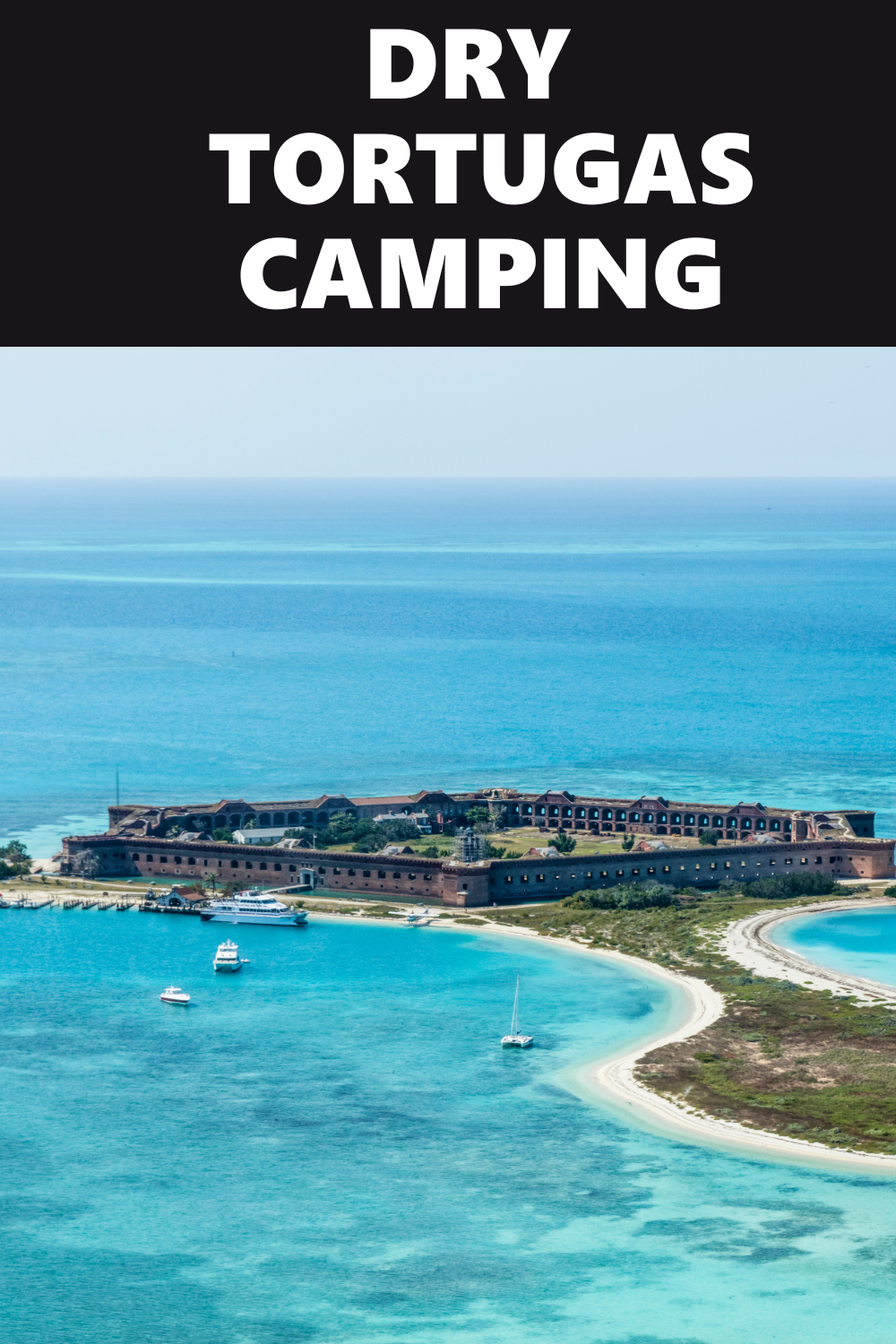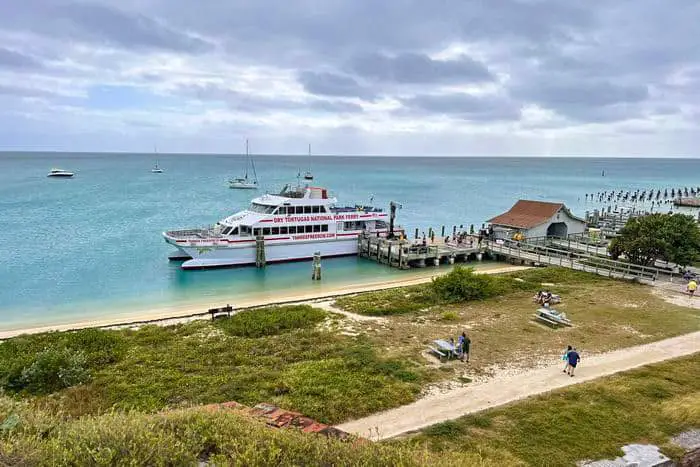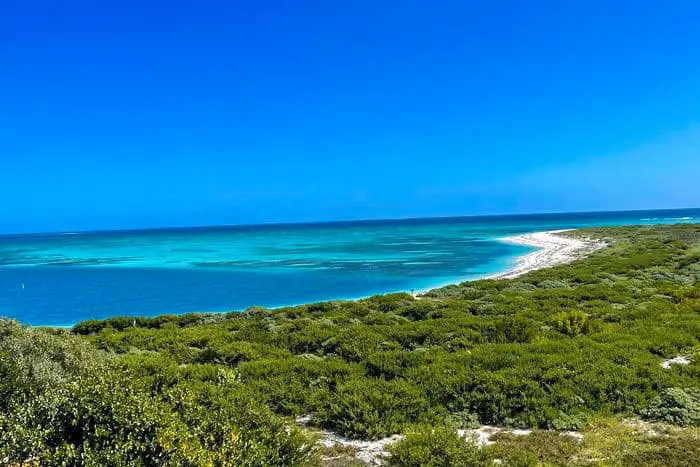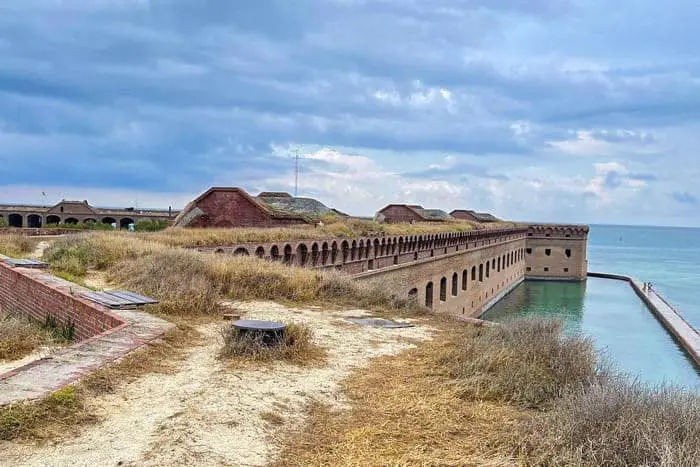The Dry Tortugas National Park is a remote location boasting seven islands along the Gulf of Mexico. I went there camping and soon found it can be difficult to say the least. I hope if you are heading out that way this guide will help you with insights on what to expect as you get in the park itself. To get there from Florida a guide is a big bonus but also a big expense. We will show how to enjoy one of the best off grid parks at your own pace of travel.
The best time to visit the channel islands which are just coral reefs is in the early spring. Late fall you run the chance of storms during hurricane season. On your early morning trip to the largest island, Loggerhead Key, spend your time enjoying the marine life along the way. The ferry is a great way to travel out here. On this private vessel everything is done for and handled for you. Some private boaters take their own boat but I would not try this unless you have a lot of experience.
The whole concept of this trip is about great sand dunes, a great spot to enjoy some of the summer months if you want to brave the heat and an ideal spot to relax.
The first thing to do upon arrival is go to the visitor center, spend some time with a park ranger and get maps. You will need to register and pay your park entrance fees.
Take it easy the first day, take a short walk, enjoy the white sands and prepare for the best primitive camping you have ever experienced. Next morning the adventure really begins.
Want more ideas to round-out your trip to Florida?
A lot of great ideas are in these posts!
- 15 Everglades National Park Free Campsites (Updated 2022)
- Best Tips for Camping the Dry Tortugas for 3 Days
- 90 Free Florida Boondocking – RV Parking and Camping Sites

Island History
It got the name when famous explorer Ponce de Leon arrived at the place in 1513 and found numerous turtles on the beach. Dry is translated from the fact that the waters are salty, which is referred to as dry in navigational terms. It is the best place to stash your loot and lay low for the ultimate off-grid camping adventure. If you are a camper looking to camp the Dry Tortugas, it offers a unique experience. No feeling beats the thrill of setting up your tent for the night with the realization that you are close to the historic 19th-century military fort surrounded by crystal clear water of the sea and the numerous beaches surrounding the quaint island.
This dramatic piece of paradise is the perfect getaway from the hustle and bustle of the city and is more than 70 miles from civilization. Camping at the Dry Tortugas offers an incredible camping experience, and the only way to get to the islands is by the sea using a private boat or the famous Yankee Freedom ferry. You can also charter a plane to the island, making for the best bird’s view of the island and its shimmering waters.
However, camping here is not cheap, and I would not recommend it to someone who wants to plan last-minute vacations. Most visitors and campers prefer the ferry mode of transport. Leave Key West in the Florida Keys across the Gulf of Mexico as early as possible. I recommend planning to secure a ticket ahead of time. This is because the national park always has visitors year-round.
There are no official camping reservations to the Dry Tortugas, but the NPS ensures that campers have a spot but limits the number of visitors coming in on the ferry to ten people per day. The reservations sell like hot cake; thus, making one ahead of time will ensure you have a spot, and I usually recommend it months in advance.
It’s noteworthy that regular ferry passengers can make their reservations online but campers have to call the office to make their reservations. It is essential to have an advanced timeline as it’s not surprising to book in, say, January and get a spot for camping in May. So plan well ahead of time for your convenience. Camping is comparatively primitive with only a bathroom; the rest of the stuff, like drinking water, you need to bring for yourself.
check out our video
Boarding the Yankee Freedom Ferry

The complete ferry trip takes about two hours and fifteen minutes to arrive at Dry Tortuga. Campers start streaming aboard the Yankee freedom at around 6:30, and this means spending the night in Key West which can be expensive for some campers. The Seashell Motel and Hotel offers relatively affordable rates, and is the only hostel in town. Campers can also check for the available Airbnb.
Upon arrival, the dock offers wheelbarrows for new campers and visitors to carry their belongings if they are heavy to the ferry. Seeing as the camping is primitive, I would advise bringing sufficient food and fresh water for drinking at the Garden Key Island where you will be staying. The ferry snack and lunch prices are a little lenient, so you can always buy lunch or snacks when the ship arrives in the afternoon.
Numerous campers pack lightly, but it doesn’t matter, as, upon arrival on the island, there are more wheelbarrows to help weary camper carry their camping gear to the campsite. In the same breath, have several gallons of fresh water, enough water for your use during your entire stay here.
It is prohibited to bring with you any flammable accelerants or canisters on the ferry. The only option for campers to start a fire is self-lighting charcoal that is locally sold on the island. Sterno cams are also another option that is allowed on the island. Campers who don’t like to cook much often can get by with room-temperature foods like sandwiches, fruits, and nuts. I would recommend cooking your meal to get the full experience of being a camper. Families on vacation are synonymous with cooking their meals, and campers always enjoy meals together. They offer complimentary breakfast on the ship, and there is also a free lunch for commuters on the boat during the voyage. It is advisable to have your free lunch on the last day when all your gear is safely on the Yankee Freedom. The lunch can be pretty basic, but it’s satisfactory.
The climate around the Dry Tortugas is relatively warm, and as such, it does not get frigid on the island. A sleeping bag and a change of sheets are enough to take you your whole stay. January boasts the coldest times of the year around the Dry Tortugas, with temperatures dropping to 18 degrees. They can also go as high as 23degrees during this period.
Securing A Campsite
Now that you are here for your visit and exploring the islands you will begin to see how remote it really is out here.Despite the size of the island, there are only ten campsites on Dry Tortuga. Even though the number of campers is limited to 10 on the island, campers coming on privately chartered boats arrive at their pleasure and can have camping space too. This is why it is recommended to arrive early because the camping slots might be full already. Upon arrival, there is a brief orientation to acclimatize the new visitors and campers on several issues regarding the island and camping. Shortly afterward, you can opt for a wheelbarrow to carry your gear and belongings to your camping spot. Traveling as a group can be advantageous at this juncture because you can send one person to secure your camping site while the rest of the people get the gear and follow behind.
Solo campers can get stuck and find all the camping sites full, which means you can only camp in the grass overflow area. This spot receives direct sunlight, which could be a little uncomfortable during hot weather in the day. The only good thing about this spot is that campers take excellent pictures as it is located just in front of the fort. If you camp for an extra night, there is a possibility of finding a much more relaxed spot since the other campers vacate their space. There are numerous shaded campsites to enjoy once the others have left. Pretty much the only difference between the two is a picnic table.

What You Get At the Dry Tortugas
The place is quite tranquil and is a good relaxing site if you are looking for solitude and tranquility. After all, the island is 70 miles to the nearest civilization offering the best escape from the heavy bustle and hustle of the city. Seeing as the ferry leaves in the afternoon, a small number of campers and the park rangers remain, leaving lots of space. This might look like the case momentarily, but campers on private boats always come around. This means that a relatively large group of campers is present at night, usually about 50, and this means that the tents are in close quarters. A more significant percentage of the camping sites have trees and shrubs that offer shade from the direct sun, but some do not.
Look out for rats because they are notorious on the island for chewing through your tent and bags to get your packed food. This is why it is advisable to pack your food in tight hard-side containers.
Mosquitoes are not an issue on the island, thanks to the sea’s salty waters. They prefer tropical freshwater beaches; thus, you do not have to worry about them. I advise having a repellant for people with allergic skin as you never know what will crawl up your skin. Hermit crabs and lizards are common sightings and might find their way to your tent, but they are not a threat.
There is always a plastic bin near the outhouse where departing campers leave their leftover supplies, and you might find an extra gallon of fresh water, plastic plates, and other usable material. It is selfless to leave your extra supplies for the other campers. The Yankee freedom advertises for showers available on the ship, but they are not ideal for a full-body wash; I recommend for rising off only since there are several sprinklers on the back of the vessels that don’t offer any privacy.
The Ideal Time To Visit The Dry Tortugas
Most visitors flock to the island at unspecified times for different reasons and seasons, making it hard to tell when to come. The islands are relatively warm throughout the year, with average temperatures between 24degrees and 18degrees during the winter. However, during this time, the sea can get a little turbulent, and this might discourage the ferry from coming to the island. On the other hand, the waters are much calmer and warmer during the summer, which is perfect for snorkeling. During this time, families with kids flock to the island to enjoy the various summer activities. Rain is frequent throughout the year, with September and August being notorious for rainfall. April and May are the driest time of the year, with minimal rain for about four days in the month.
Due to the limited campsite at the national park, there are no guarantees about the crowd of campers and visitors that might show up. The last two months of the year could be a little less crowded. This is because people and the snowbirds head south for the winter. June to November is notorious for hurricanes, so you might consider that risk when planning your trip.
These conflicting factors could seem a little confusing, but there are advantages and disadvantages to the time of the year that you choose to go camping. Plan when it suits your schedule bearing in mind that other like-minded campers and visitors are also thinking the same. This means there is no least crowded time, but camping, which is only allowed around Fort Jefferson, is worthwhile any time of the year due to its scenic environment.
I think the biggest and most important thing I can stress is staying hydrated on the Dry Tortugas. It is the key to the success and safety of your ultimate adventure on the islands west of Florida. For those reasons always look out for the same with your family. It is the key to the success of your trip. There is no fresh or running water on the islands.
Visiting Fort Jefferson

Fort Jefferson is a large coastal stronghold that has yet to be completed. It is the world’s largest brick masonry edifice, made up of more than 16 million bricks. The structure is 16 acres in size (6.5 ha). Only Fort Monroe in Virginia and Fort Adams in Rhode Island are larger forts in the United States. Garden Key is located in the lower Florida Keys, within the Dry Tortugas National Park, 68 miles (109 kilometers) west of Key West. The Dry Tortugas are located in Monroe County, Florida, and are part of the United States.
Construction
Commodore David Porter of the United States Navy surveyed the Dry Tortugas islands in late December and early January 1825, nearly five years after Spain sold Florida to the United States for $5 million. He was looking for a location to build a naval post to help combat piracy in the Caribbean. He informed the Secretary of the Navy that the Dry Tortugas were unfit for any kind of naval base, unimpressed with what he observed. He claimed that they are made up of small sand islands just above the ocean’s surface, that they have no fresh water, that there isn’t enough land to build a stronghold, and that they aren’t substantial enough to support one.
While Commodore Porter believed the Dry Tortugas were unsuitable for a naval station, others in the US administration believed the islands would be an ideal place for a lighthouse to guide ships past the area’s reefs and small islands. The lighthouse, which became known as Garden Key Light, was built on a small island called Bush Key, later renamed Garden Key. Construction started in 1825 and ended in 1826. The whitewashed exterior of the 65-foot (20-meter) lighthouse was made of brick. A tiny white residence was built beside the lighthouse for the lighthouse keeper.
Civil War
62 troops from the Second U.S. Artillery Regiment, under the command of Major Lewis Golding Arnold, were transferred to the fort at the start of the Civil War to prevent it from falling into the hands of rebel forces. In 1860, Capt. Meigs took over as Superintending Engineer and worked tirelessly to upgrade the fort’s security and fortifications, with the heavy cannons firing for the first time on January 26, 1861. At the time, the fort had a population of 168 people, including women and children.
On July 4, 1861, two companies of the 6th New York Zouaves, totaling 160 soldiers, landed under the command of Col. Bill Wilson. The 7th New Hampshire Volunteer Infantry, commanded by Col. Haldimand S. Putnam, arrived in March 1862 to relieve the Zouaves. In June 1862, the 90th New York Volunteer Infantry Regiment, commanded by Lt. Col. Louis W. Tinelli, relieved the New Hampshire troops. The 47th Pennsylvania Infantry Regiment relieved them in December 1862. The 110th New York Volunteer Infantry relieved them in March 1864.
Designation of a Park
President Franklin D. Roosevelt established the Fort Jefferson National Monument on January 4, 1935. The Works Progress Administration worked on site between 1935 and 1938, renovating and preserving the structure. On November 10, 1970, it was added to the National Register of Historic Places. The Dry Tortugas National Park, which includes Fort Jefferson, was established on October 26, 1992.
Cost Implications For Camping At the Dry Tortugas
Spending for the Dry Tortugas begins when making a reservation spot on the ferry. The ferry operators are available on call at 1-800-634-0939. You can always call ahead and make your reservations, as well as ask any questions regarding the transportation. Ferry charges are usually $190 for adults and $135 for children. There is only a slight discount for active military personnel, students, and seniors. Members with Interagency Senior and Access passes enjoy a discounted rate of up to 50% discount.
It gets quite expensive when you factor in the lodging cost the night before the departure day at Key west beside the additional campground fees. Camping payments are usually cash. Thus, you might want to have some loose change when coming to the island. It usually costs around $15 per person to camp, and the cash can be deposited at the pay station. It’s noteworthy that the baggage area on the ferry might get wet during the cruise; thus, passengers are advised to bring waterproof bags or use plastic bins. The ferry has a sitting capacity of 250 people, with half inside and the other half on the deck.
Important information to note
The bathroom facilities available on the Dry Tortugas are glorified outhouses with composting toilet amenities. They are not fancy, so do not expect anything more. In the afternoon, when the ship has docked, you can use its bathrooms better than the compost toilets. Most people take advantage of this option.
All camping gear must be freestanding. As such, they do not allow hammocks and laundry lines between the trees. Campers can bring their equipment up to 60 pounds each, and it is pretty generous, water gallons notwithstanding. They allow as much water as you can carry. A garbage bag will come in handy to keep all your trash and dispose of it later at the designated point of trash dumping.
They allow booze in the park, but glass bottles are prohibited. You can opt for plastic bottles and store your wine or liquor. This is only for your enjoyment as campers generally look for solitude, so this might be a surprise if you are a reveler looking for some party time.
Tips and Regulations
Limited space- a standard campsite has one table, a mount for hanging food, and a barbeque grill to burn your steak. Only three tents and two campers in each are allowed on a particular campsite. All your gear must be within 10 feet of your table.
No wood fires- self-igniting charcoal and stern cans are the only modes of fire allowed on the campsite. Gas stoves and propane canisters are prohibited on the island. This should help to plan your meals early enough. Saving on free lunch on the Yankee Freedom ferry is highly recommended.
Grey water- water from dishwashing and other activities should be drained at the high tide line near the dinghy beach. It is always good to take care of the environment and follow the rules to avoid inconveniencing other campers. Rangers are constantly patrolling to ensure the rules are followed.
Park vegetation- you should always protect park vegetation. The trees and shrubs available at the camping sites provide good shade, especially during the day. The trees also shield against strong winds that might blow your tent away if you have not anchored it properly to the ground. It is advisable not to attach anything, including hammocks ad laundry lines, between the trees unless at the designated spots. Always keep off the closed areas of the park.
Kayaks and snorkeling equipment: Boats can be kept in the designated spots near the dingy beach. All kinds of boats are prohibited in the swim area and this is enforced by the rangers patrolling the grounds. The dingy beach located near the government docks is the only designated area for launching the boats. It is advisable to put on a life jacket at all times during boat activities on the sea.
Toilets- There are no fancy bathrooms on the campgrounds, but compost toilets are available. There is composting equipment beneath the units. The systems are pretty primitive and are only designed for human fecal matter and toilet paper, so don’t go dumping any other waste around there. Trash and food scraps are heavily prohibited from being dumped in the toilets to avoid spoiling the equipment. To reduce odors and promote the composting process, please close the toilet lids after you are done. Since the commercial toilets are closed from about 10 am to 3 pm, campers can take advantage of the much fancier bathrooms of the ferry wen its docks during the afternoon.
Tranquil hours- it usually lights out from 10 pm to about 6 am, and bright lamps are discouraged. It is good to be considerate of other campers on the site.
Departure
On the final day of Dry Tortugas amping, clear out all your trash and dump it in the designated trash areas. All camping gear must be carried to the main dock to be loaded onto the ferry, and all handcarts must be turned in by 10 am. Only have the items that you will need during your voyage back.
You May Want to Join Our Boondocking Group on Facebook For More Information
You May Want to Join Our Campfire Recipes Group on Facebook For More Information
Check Out Our Pictures On Instagram – Our Big Escape.

